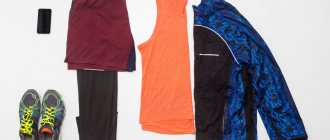Winter is not a reason to move your workouts to a stuffy gym. Yes, running in winter is mentally and physically harder than running in the warm season, but without winter training it is difficult to count on any results in spring and summer. The article explained how and where to run in winter, what equipment is needed for this, and answered the most popular questions of novice runners.
- Is it possible to run in winter?
- At what temperature can you run in winter?
- Where to run in winter?
- How to run properly in winter?
- How to run in winter and not get sick?
- What sneakers should I run in in winter?
- Running clothes in winter
- How to breathe while running in winter?
- Drinking while running in winter
- Video about running outdoors in winter
Is it possible to run in winter?
You can and should run in winter. The ideal option is to go “winter” in a mild climate, as the professionals do, but not everyone has this opportunity. However, there are many strong runners who train on snow in winter. Not to say that these are good conditions for running, but it has its advantages. In winter, you can strengthen your immune system, pump up your ligaments and stabilizer muscles, improve coordination, and learn to endure bad weather.
Source: Shobeir Ansari / Alarmy
Where to run in winter?
The best option is to run on trails or paths in the park. Sometimes you have to run on city sidewalks or roadways, and this means gas pollution, dirt with reagents, and traffic lights. When running along city streets, make your route along busy roads with a minimum of traffic lights. Regardless of where you train, you need to take some precautions when running in winter:
- For evening solo workouts, choose a small, well-lit circle.
- If you have to run on unlit streets or parks, buy a running light
- Wear bright, reflective clothing so you can be seen from afar
- Always take your phone and money with you when taking a taxi
- If you have to run along the roadway, run against the traffic
- Take pepper spray with you for self-defense - it will help fight off stray dogs and inappropriate people
How to run properly in winter?
Running in winter is dangerous due to sprains and falls; on the other hand, unstable surfaces will help strengthen the muscles of the legs and feet. The slippery surface will not allow you to place your foot at random. The body itself will adjust the running technique: the steps will become shorter, the cadence will increase, the foot will be placed under the center of gravity - this will help improve the technique for the competitive period. Run softly, without sharp push-offs or “sticking”.
Read on: How to run correctly? Natural running technique.
To avoid injury, be sure to warm up indoors before going out to train: warm up your muscles, ligaments and joints. But don't overdo it, you need to warm up without breaking a sweat to avoid freezing outside.
Be guided by the weather
In winter, it is important to be aware of sudden temperature changes and changeable weather conditions. For example, in icy conditions you can slip on the ice and fall, and in cold weather you can get frostbite. And training on ice crust and snowdrifts requires much more effort than in warm seasons.
During winter activities, it is important to run less than half the distance so that you can always return home on time and not freeze. It's also a good idea to check your thermometer before exercising. If it is -40 C outside, then outdoor activities should be rescheduled to another day or to a warmer season.
Andrey:
My most important advice is to ask yourself, is it really necessary for you to run in winter? Starting to play sports is stressful in any case. And the more obstacles and additional inconveniences that stand between you and training, the higher the likelihood that your hobby will end much earlier than it could. And taking into account the bad weather, also with a sick leave.
Therefore, I sincerely advise you not to subject your willpower and determination to enter 2022 “in sports” to unnecessary tests. You can easily survive the winter on the treadmill in the fitness club; there are also horizontal bars there. And on the Internet there are a million workout complexes at home. Believe me, by postponing your acquaintance with the delights of running in the fresh air at least until April, you will have time to do everything. Of course, if you now start exercising regularly in more “greenhouse” conditions. By the way, don’t think that 2-3 months in a fitness center will be much more expensive than winter equipment.
Question of the day. Does running help you lose weight?
How to run in winter and not get sick?
- Get used to the cold gradually. With regular training and lowering the temperature, the body itself adapts. If you missed the whole fall and decided to resume training in the winter, start with small, slow cross-countries. Restrain yourself, even if it seems easy to run
- Keep your neck, head and ankles warm
- After training, immediately go into a warm place or change into dry clothes.
- Warm up, stretch and exercise indoors
- Run in synthetic running gear
- Wear long socks and leggings
- Follow the standard rules for a healthy immune system: get enough sleep, eat well, avoid overload
Source: france-montagnes.com
What sneakers should I run in in winter?
Winter running shoes differ from summer ones because they are not insulated, like everyday shoes. There is no need for insulation, because the foot is not cold while running. In winter sneakers, it is important to have a dense, water-repellent upper material, shock absorption that does not harden in the cold, and a non-slip tread. It is very comfortable to run in such sneakers in winter, spring and autumn, but it is not necessary to buy such sneakers. Many runners use regular summer asphalt models in winter, especially if the city has well-cleaned paths.
If in winter you have to run on slushy snow or paths in the park, and you want to run in complete comfort, pay attention to several factors:
- off-road tread (possibly with metal spikes)
- dense mesh or membrane to protect against cold and moisture
- preferably a closed top or gaiters to prevent snow from getting in
Examples of running shoes for winter:
- Salomon Speedcross is a proven running shoe with an aggressive tread for running in slush and packed snow.
- Asics Gel-FujiTrabuco - universal sneakers for any off-road in winter and summer
- Asics Gel-Sonoma - running shoes for light off-road running, well-trodden paths and snowy city streets
- Nike Pegasus Trail - all-rounder for light off-road and city streets
- Adidas Terrex - sneakers for soil, snow, mud, stones
- Salomon Snowspike CSWP - winter running sneakers with metal spikes and built-in gaiter
Read on topic: How to choose running shoes in winter.
Source: blog.runningcoach.me
Belly breathing
The correct name is diaphragmatic breathing. It can be easily performed at rest. Suitable as a lung development exercise, helps with pain in the upper abdomen and side during running .
Diaphragmatic breathing does not need to be used all the time, especially when running. When breathing from the stomach, the abdominal muscles are loaded with unnecessary work and cease to participate in stabilizing the body. It takes a lot of effort, the equipment falls apart. It is much more important to run correctly and economically than to invent something with your breathing. By the way, if you don’t believe me, try running a half marathon breathing from your stomach.
Breathing exercises can be effective for developing the lungs and strengthening the diaphragm. But it is not performed while running, but only in a calm state.
Clothes for running outdoors in winter
A common mistake novice runners make in winter is wearing too warm clothes. To run, you need to dress as if it were 10° warmer outside. That is, to run in -15°, dress as if it were -5° outside. In the right equipment, it will be a little cool at the beginning of the run, but it will become comfortable after 1-2 km.
The most important thing in winter running clothes is to wick away excess moisture. Therefore, choose clothes made from synthetics and follow the principle of layering. Do not use cotton, wool or other natural materials. Read more in our article How to dress for running in winter.
How to breathe while running in winter?
Breathe as you feel comfortable. It is optimal to breathe through your nose and mouth at the same time, but not everyone succeeds. Forget about the advice to breathe only through your nose - it will be harder to run, and a strong flow of cold air can burn the nasal mucosa.
If you are not used to it, there is a risk of inhaling and catching a respiratory tract infection, so get used to the cold air gradually. As the weather gets colder, reduce interval and speed training and run gentle cross-country runs while your body adapts to the cold.
Read on: How to breathe while running?
conclusions
Running correctly in winter brings enormous benefits to your body. As a result of such training, the following occurs:
- Increasing body endurance
- Saturation of blood with oxygen, its dilution, which reduces the risk of blockage of blood vessels
- Strengthening the immune system. Regular jogging significantly reduces the risk of seasonal colds
- Strengthening the heart muscle
- Active calorie burning. The body uses energy to maintain heat and maintain physical activity.
From a physiological point of view, cold is more acceptable for running training than heat. However, winter running is not an activity for beginners. Such workouts are more difficult than usual, but they strengthen not only the body, but also the spirit, filling you with energy and teaching you not to stop at any obstacles on the way to your goal. So choose the right equipment, master your breathing technique and run to your health!
Drinking while running in winter
During the cold season, you want to drink less, but the body still loses a lot of fluid through breathing and sweat. Therefore, if your workout lasts more than an hour, take a warm drink with you. Sports stores sell insulated running belts where you can put a bottle or soft flask. You can use a regular summer belt, but instead of a flask, buy a small thermos. If you run in one circle, you can hide the thermos at the distance or leave it in the car.
For long workouts or winter trails, use a running backpack with a hydration pack. To keep your drink from getting cold, you can insulate your hydration pack or wear a backpack under your running jacket and hide the tube from the hydration pack there.
Read on the topic: All about isotonics and drinking while distanced.
Dress in layers
The main task of winter training clothes is not just to keep you warm, but also to keep you from getting wet from sweat in order to avoid hypothermia. When running, the areas that sweat the most are the forehead, the neck just below the back of the head, the armpits, the solar plexus and the lumbosacral region of the back. The hands, elbows, knees, groin and feet also have increased heat transfer, but produce less sweat.
In cold weather it is better to dress in 3-4 layers of technical equipment. They will provide comfort even during long training sessions and competitions.
- The first layer
is thermal underwear. It removes moisture and excess heat from the body. - The second layer
is insulating, made of fleece or Polartek. They retain heat and help not freeze. - The third layer
is protective, windbreakers or membrane jackets. They protect from wind, rain, snow and do not retain moisture. If the top layer “breathes” well, then the middle and bottom layers dry quickly. - The fourth layer
is additional insulation for particularly severe frosts, a thin down jacket or another fleece jacket. It is important that this layer also wicks away moisture well.
Andrey:
Thin and light ski jackets made using membrane technology are perfect as a third layer. They perform their functions well and do not restrict movement. The only inconvenience is the price. In general, I advise you to look for most of your equipment in the sections for skiers. Almost anything will do except ski boots.
Photo: istockphoto.com










